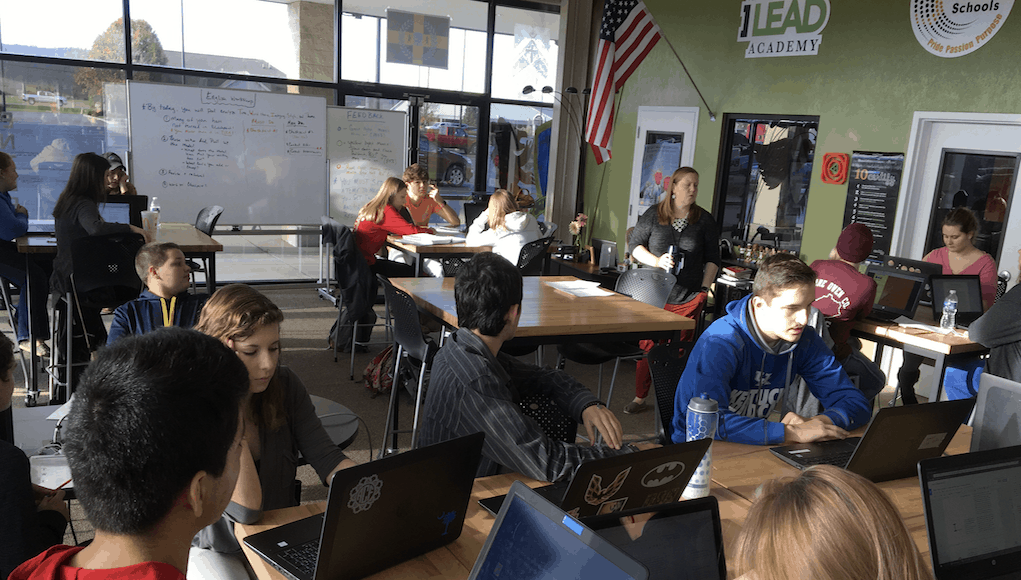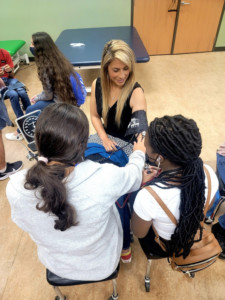iLead: Student-Centered, Career Focused, Accelerated Learning

Four years ago, five central Kentucky superintendents agreed to form a cooperative high school offering STEM-focused PLTW course of study. They asked Alicia Sells, the Ohio Valley Educational Cooperative Director of Innovation, to work on it—and they got more than they bargained for.
Sells asked, “What problem are we trying to solve?” This led to student interviews from each of the districts. Students expressed interest in real world application and meaningful career opportunities.
The next year iLEAD Academy (@iLEADacademyKY) opened with 45 freshmen in a Carrollton strip mall abandoned after a super Walmart opened across the street.
9 Reasons to Visit iLEAD
Flexible space. They converted retail space into open spaces with flexible furniture. A makerspace has all the equipment you’d need to build just about anything and support a robotics club. Breakout rooms support small group meetings.
Personalized learning. After trying a couple of canned programs, the iLEAD teachers applied to become part of the Summit Learning network. Compared to asynchronous curriculum, the students like the teacher-led units.
English teacher Jessica Crenshaw likes the ability to provide more frequent feedback. She said the platform promoted self-regulation, time management, and note-taking skills. The Buck Institute trained teacher augments the personalized learning platform with periodic projects and exhibitions (like an upcoming poetry slam).
Design thinking from day one. Junior Josiah appreciated Intro to Engineering as a freshman and Principles of Engineering as a sophomore. He noted that most projects took three or four designs to achieve success.
 According to Jenna Gray, Engineering & Math teacher, “In a traditional school many times kids do not understand the purpose of what they have to learn. With our makerspace we can learn content in the classroom then go directly into the makerspace and see how it works.”
According to Jenna Gray, Engineering & Math teacher, “In a traditional school many times kids do not understand the purpose of what they have to learn. With our makerspace we can learn content in the classroom then go directly into the makerspace and see how it works.”
College in high school. Students enroll at iLEAD with the goal of earning an associate degree from Jefferson County Technical College (JCTC) with their high school diploma. They know that doing six years of academic work in four will require focus and diligence.
Thirty-three juniors are pursuing full-time studies at JCTC. They will finish the year with an average of 30 college credits.
Some supportive parents find iLEAD and encourage enrollment. For other students living in chaotic drug-addled home environments, iLEAD represents an affordable path to family-wage employment.
Hug and a push. iLEAD Academy Director Larisa McKinney will often start the student day with a hug but then comes encouragement to do better and think bigger. The small school environment means less drama and more personalized attention.
Career pathways. Some incoming ninth graders have a career in mind. Sometimes their coursework and job shadows confirm that hunch. Junior Alex knew from day one that the engineering pathway was for him. His recent state championship in engineering design suggests he’s on the right path. He still finds programming robots to be challenging but learns from every design flaw.
Alexis thought programming would be her passion but she tried it and didn’t like it. Instead, she’s focusing on a biomedical career path.
Jordan wanted to be a teacher but took an introductory class and worked in a school and decided it wasn’t for her. She’s now loading up on STEM courses aiming at UK dentistry school with the goal of being an orthodontist.
Kylie chose the nursing pathway and will earn a certificate as a medical nurse assistant and work in healthcare delivery. She is also in biomedical engineering and in TSA (Technology Student Association).
Ocsar, a junior who takes math, psychology and English at JCTC has switched areas of focus several times and decided to focus on the arts. He plans to continue at KU with a concentration in music composition.
Career pathways include STEM-focused PLTW curriculum, industry certificate opportunities, job shadows and work experiences.
Personalized guidance. Career pathways are supported by weekly coaching sessions with a mentor. iLEAD teachers mentor about 24 multi-aged students that meet weekly. During a standing one on one appointment mentors review academic progress and struggles. They identify any out of school barriers.
“Teachers ask, “What do you want to do? They care about you and your passion,” said third-year Storm who is pursuing a career in electrical engineering but also enjoys creative writing and movie making. She has already earned certifications in industrial maintenance and her OSHA 10 and is confident she’ll be well prepared to compete in male-dominated field because of a set of opportunities not offered at traditional high school
Second and third-year students mentor incoming freshmen and help them make sense of all the choices available to them.
Public product. The Buck Institute for Education recommends public student work products to promote authenticity, quality, and agency. At iLEAD, students make frequent public exhibitions and post a digital portfolio on the platform of their choice.
Cendia shared her portfolio which included a variety of engineering projects including products from Maker Day, the Puzzle Design Challenge, and a mobile app challenge. Her portfolio also included reflections from her job shadow with a school administrator (she found out it’s hard!).
Community connections. Most students maintain connections with their sending high school including participating in sports, FAA, honor society, and social activities.
Four Barriers
1. EdTech is still a barrier. It’s still really complicated to stitch together a a personalized learning environment. Students at iLEAD take core courses on Summit Learning, PLTW courses on Canvas and walk down the street to JCTC where Blackboard is also used. Grades are captured in Infinite Campus and shared with sending schools that provide a transcript. It’s a lot more complicated than it should be.
2. Policy is still a barrier. In Kentucky, high school student pay for college credits. They get a couple classes free and then a discounted tuition but it still depresses dual enrollment in a state that should be encouraging it. Scaling dual enrollment will require Kentucky high schools to give up the funding for courses taken at a community college.
3. Incentives are still a barrier. Standards-based accountability got principals focused on test scores and graduation rate. An unintended consequence is that principals want to hang on to diligent students (as well as the money associated with those students). We need better measures of the contribution to growth that schools make and incentives rather than disincentives for connecting students with opportunity.
4. Low expectations are still a barrier. Almost every student can and should earn college credit in high school—it allows them to experience success in what’s next and it saves them some money. Many students could graduate from high school in three years with some college credit or leave in four years with a college degree. We know from the national success of hundreds of early college high schools that this works for all kids—first generation, low income, dropouts and high flyers.
Advice
About creating a new school, director McKinney said, “You just have to forget about all the rules and think big.”
But conversely, “Sometimes you have to spend all day with one student,” said McKinney. The secret sauce at iLEAD (to borrow a Big Picture phrase) is career pathways created one student at a time.
Founder Alicia Sells said it starts with relationships. She appreciates what staff does to help every kid be what they want to be. With the power of relationships, “Nothing is impossible.”
About teaching in a nontraditional environment, Jessica Crenshaw said, “You have to be OK with losing control.” The key is thinking outside the traditional box and empowering students to take ownership of their own learning.
Mentioned in This Episode:
For more see:
- 8 Things to Look For in a Student-Centered Learning Environment
- What Makes High Quality PBL?
- 12 New Rules: Accelerated Learning for an Exponential World
Stay in-the-know with all things EdTech and innovations in learning by signing up to receive the weekly Smart Update.





0 Comments
Leave a Comment
Your email address will not be published. All fields are required.